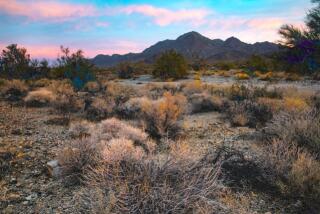Burial Site Discovery Halts Development
- Share via
State officials have halted construction of a gated community in Seal Beach after the discovery of the remains of at least 18 Native Americans on land a local tribe considers a sacred burial ground.
The cease-and-desist order by the California Coastal Commission is the latest twist in the 21-year history of the Hellman Ranch, a 196-acre property between the Seal Beach Naval Weapons Station and the San Gabriel River.
While Native American activists picketed the Heron Pointe project Monday, a representative of developer John Laing Homes said the company had reached an agreement with official representatives of the Tongva people to conduct extensive archeological testing on the site.
“John Laing Homes is sensitive to the privacy of Native American descendants, and any recovery of remains we are managing with the dignity and respect they deserve,” said Joanie Madrid, Heron Pointe project manager.
The commission issued the stop-work order last month, halting the grading of pads for 70 single-family homes on 18 acres of the ranch. Peter Douglas, the commission’s executive director, said the agency’s staff asked the developer to halt work once the remains were found.
Douglas said he issued the order only after the developer refused to halt work voluntarily. Madrid disagreed, saying grading was stopped Sept. 14--two days before the order was issued.
Commission staff members are scheduled to meet today with the developer and Native American groups in Long Beach. Douglas said he is not interested in penalizing Laing Homes, only in making sure that the remains are handled properly.
The agency issued final approval for the project late last year, allowing development near the San Gabriel River and requiring 150 acres to be sold eventually for conservation and wetlands restoration.
Madrid said the developer has reached an agreement with the monitors, and the “most likely descendant” of the local tribe, who is assigned by the Native American Heritage Commission. The developer will excavate more than 100 test sites. Finding bones or artifacts will lead to additional digs.
“The goal is to find anything that is in the ground,” Madrid said. “We’ve been working very closely with Native Americans all along.”
But one Native American monitor said there is no agreement on what to do with the remains, and other issues are also unresolved. Remains now are being stored and will eventually be reinterred.
Jordan David, who said a total of 20 sets of remains have been unearthed and expects more to be found, disputed the developer’s assertion that it has worked with the Native American community. David said that at one point, he and another monitor had to stand between a burial site and bulldozers to stop it from being destroyed.
“My job is to ensure the safety of the ancestors and artifacts out there,” he said. “Beyond that, it’s my duty as a Native American to stop somebody from desecrating a spiritual area, specifically a burial site.”
Madrid, however, said that no confrontation occurred and that the story was being spread by a monitor who opposes any development. A handful of activists continued picketing the site Monday evening.
Andy “Young Plow” Morales said he would like to see all development stopped. “Our goal is to preserve the land, to protect the land and to protect the buried ancestors,” said Morales, the son of the chief of the Gabrielino-Tongva Nation.
“Our ancestors have been dug up and disturbed.... How would [the developer] like it if Native American people go to their ancestral land, dig up their ancestors and put them in boxes or museums, or throw them away in the trash and abuse them?”
More to Read
Sign up for Essential California
The most important California stories and recommendations in your inbox every morning.
You may occasionally receive promotional content from the Los Angeles Times.














